2013 Pagani Huayra first drive

MORE AT MOTORTREND.COM
» MG LE50 First Drive: Modern Take on Legendary MGB Is Big Fun
» Spied: 2015 Ford Mustang Test Mule Disguised as 2013 Mustang GT
It's tempting to dismiss the Pagani Huayra as another fringe hypercar -- another exclusive, expensive, pointless toy for the collector who's bored with his Ferraris and wants to tool around to the country club in something his rich buddies don't have. Tempting, that is, until you drive it.
The Huayra is the follow-up to the Zonda, the debut model from self-taught supercar auteur Horacio Pagani. It features an all-new chassis with a central monocoque made from titanium-infused carbon fiber, and the wheelbase has been stretched 2.75 inches over the Zonda. The suspension is pure race car stuff: double wishbones milled from billets of a copper-rich aluminum alloy called Avional, with pushrod-actuated Ohlins shocks.
The carbon bodywork was styled by Pagani himself, and features active aerodynamics -- flaps at each corner of the car that can move independently and alter downforce according to inputs from sensors that measure speed, lateral and longitudinal acceleration, roll, and steering angle. The suspension will also automatically lower the nose to increase the car's angle of attack and increase downforce at speed.

Here's the simple math: The Huayra weighs less than 3000 pounds (dry) and has 720 horsepower. Oh, and it also has more than 737 lb-ft of torque, courtesy of a new 60-degree, 6.0-liter twin-turbo V-12 developed expressly for the car by the engine wizards at AMG, replacing the 7.3-liter naturally aspirated AMG V-12 in the Zonda. The mid-mounted engine drives the rear wheels through a seven-speed, single clutch automated manual transmission built by Xtrac, the British company that makes trannys for F1 cars and Le Mans prototypes.
There was some wrangling over the new engine's configuration. Horacio Pagani didn't like the idea of turbos, and didn't like the naturally aspirated V-8 AMG first proposed as a replacement for the Zonda's 7.3. He wanted a V-12, but AMG engineers were insistent that to meet emissions and fuel consumption standards through the next decade, the engine had to have forced induction. AMG clearly knew what it was talking about. At cruising speeds, the Huayra is one of the most fuel-efficient supercars in the business, says Pagani, brandishing figures fresh from the test lab showing it has achieved 21 mpg (U.S.) on the Euro highway cycle.
Nailing the gas in the Huayra is like lighting the afterburners on an F-15, though. The new V-12, codenamed M158 in AMG-speak, will pull cleanly and smoothly from as little as 1000 rpm, but once the tach needle swings past the 2500 mark and the turbos get into their comfort zone, the thrust is epic and utterly relentless all the way to 6000 rpm. I didn't go past 160 mph more than once on the bumpy, busy autostrada near Bologna, but the Huayra got there without breaking sweat; a casual canter en route to its claimed 230 mph top speed.


 Yahoo Autos
Yahoo Autos 
